Organisational Behaviour Report: Ryanair, Culture, Motivation, Teams
VerifiedAdded on 2021/02/20
|16
|5529
|30
Report
AI Summary
This report delves into the complexities of organisational behaviour, using Ryanair as a case study. It examines how organizational culture, politics, and power dynamics influence individual and team performance, exploring the impact of these factors on employee behaviour. The report then evaluates content and process theories of motivation, providing insights into how to achieve organizational goals. Furthermore, it differentiates between effective and ineffective teams, highlighting key characteristics and strategies for success. Finally, it applies organizational behaviour concepts to real-world business situations, offering practical recommendations for improving business performance and productivity within the context of Ryanair. The analysis incorporates various theories and models, such as Handy's typology of organizational culture and Maslow's hierarchy of needs, to provide a comprehensive understanding of the subject.
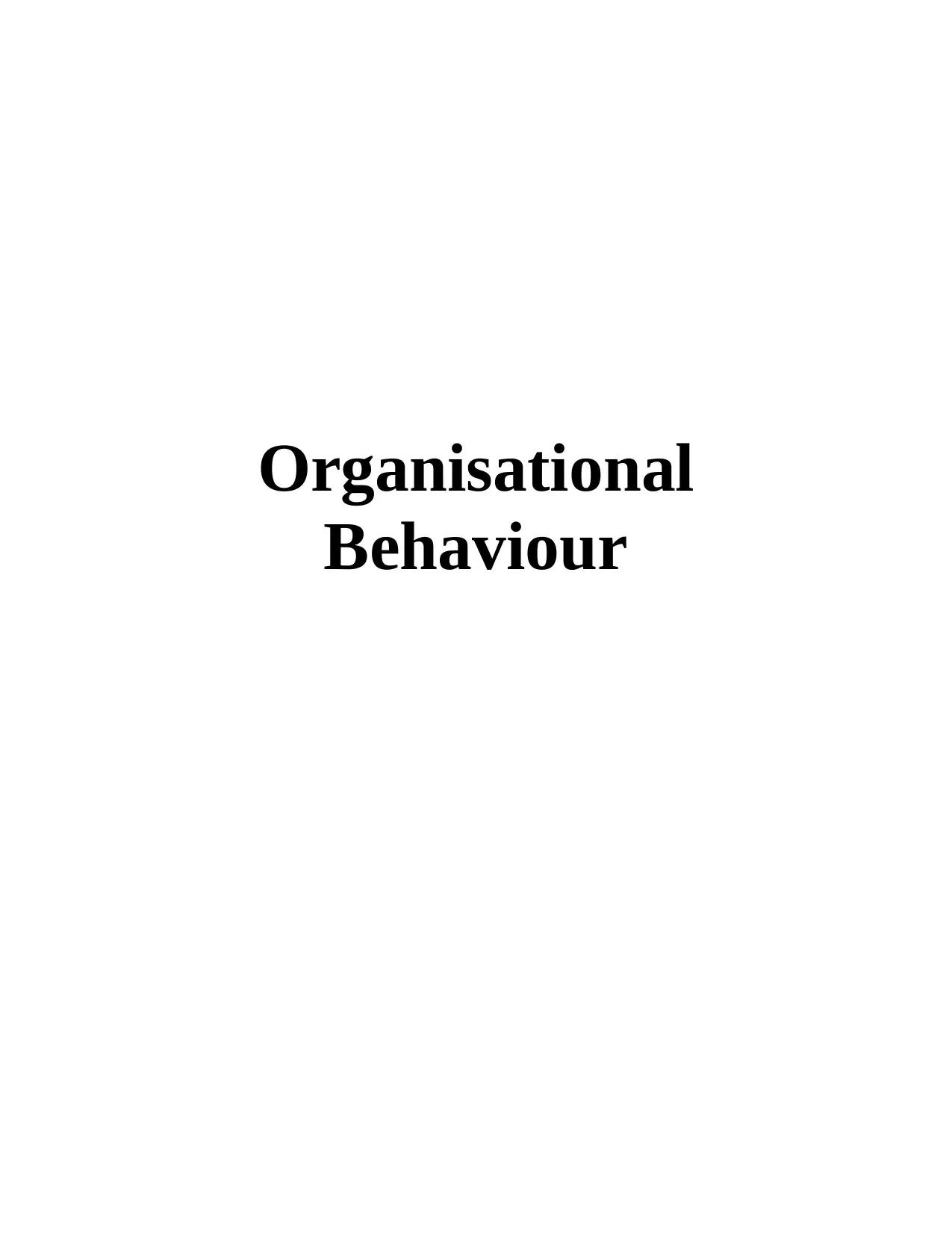
Organisational
Behaviour
Behaviour
Paraphrase This Document
Need a fresh take? Get an instant paraphrase of this document with our AI Paraphraser
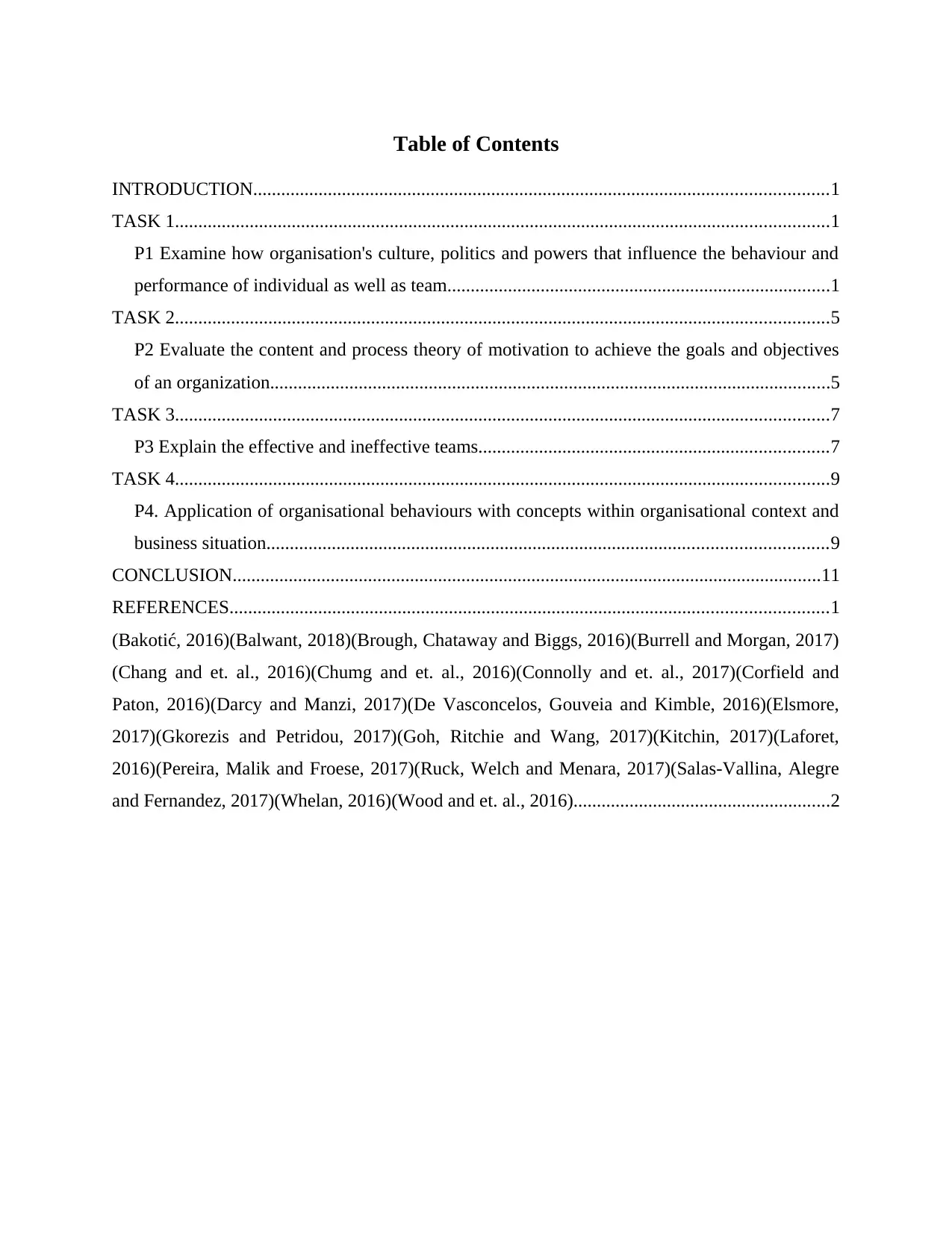
Table of Contents
INTRODUCTION...........................................................................................................................1
TASK 1............................................................................................................................................1
P1 Examine how organisation's culture, politics and powers that influence the behaviour and
performance of individual as well as team..................................................................................1
TASK 2............................................................................................................................................5
P2 Evaluate the content and process theory of motivation to achieve the goals and objectives
of an organization........................................................................................................................5
TASK 3............................................................................................................................................7
P3 Explain the effective and ineffective teams...........................................................................7
TASK 4............................................................................................................................................9
P4. Application of organisational behaviours with concepts within organisational context and
business situation........................................................................................................................9
CONCLUSION..............................................................................................................................11
REFERENCES................................................................................................................................1
(Bakotić, 2016)(Balwant, 2018)(Brough, Chataway and Biggs, 2016)(Burrell and Morgan, 2017)
(Chang and et. al., 2016)(Chumg and et. al., 2016)(Connolly and et. al., 2017)(Corfield and
Paton, 2016)(Darcy and Manzi, 2017)(De Vasconcelos, Gouveia and Kimble, 2016)(Elsmore,
2017)(Gkorezis and Petridou, 2017)(Goh, Ritchie and Wang, 2017)(Kitchin, 2017)(Laforet,
2016)(Pereira, Malik and Froese, 2017)(Ruck, Welch and Menara, 2017)(Salas-Vallina, Alegre
and Fernandez, 2017)(Whelan, 2016)(Wood and et. al., 2016).......................................................2
INTRODUCTION...........................................................................................................................1
TASK 1............................................................................................................................................1
P1 Examine how organisation's culture, politics and powers that influence the behaviour and
performance of individual as well as team..................................................................................1
TASK 2............................................................................................................................................5
P2 Evaluate the content and process theory of motivation to achieve the goals and objectives
of an organization........................................................................................................................5
TASK 3............................................................................................................................................7
P3 Explain the effective and ineffective teams...........................................................................7
TASK 4............................................................................................................................................9
P4. Application of organisational behaviours with concepts within organisational context and
business situation........................................................................................................................9
CONCLUSION..............................................................................................................................11
REFERENCES................................................................................................................................1
(Bakotić, 2016)(Balwant, 2018)(Brough, Chataway and Biggs, 2016)(Burrell and Morgan, 2017)
(Chang and et. al., 2016)(Chumg and et. al., 2016)(Connolly and et. al., 2017)(Corfield and
Paton, 2016)(Darcy and Manzi, 2017)(De Vasconcelos, Gouveia and Kimble, 2016)(Elsmore,
2017)(Gkorezis and Petridou, 2017)(Goh, Ritchie and Wang, 2017)(Kitchin, 2017)(Laforet,
2016)(Pereira, Malik and Froese, 2017)(Ruck, Welch and Menara, 2017)(Salas-Vallina, Alegre
and Fernandez, 2017)(Whelan, 2016)(Wood and et. al., 2016).......................................................2
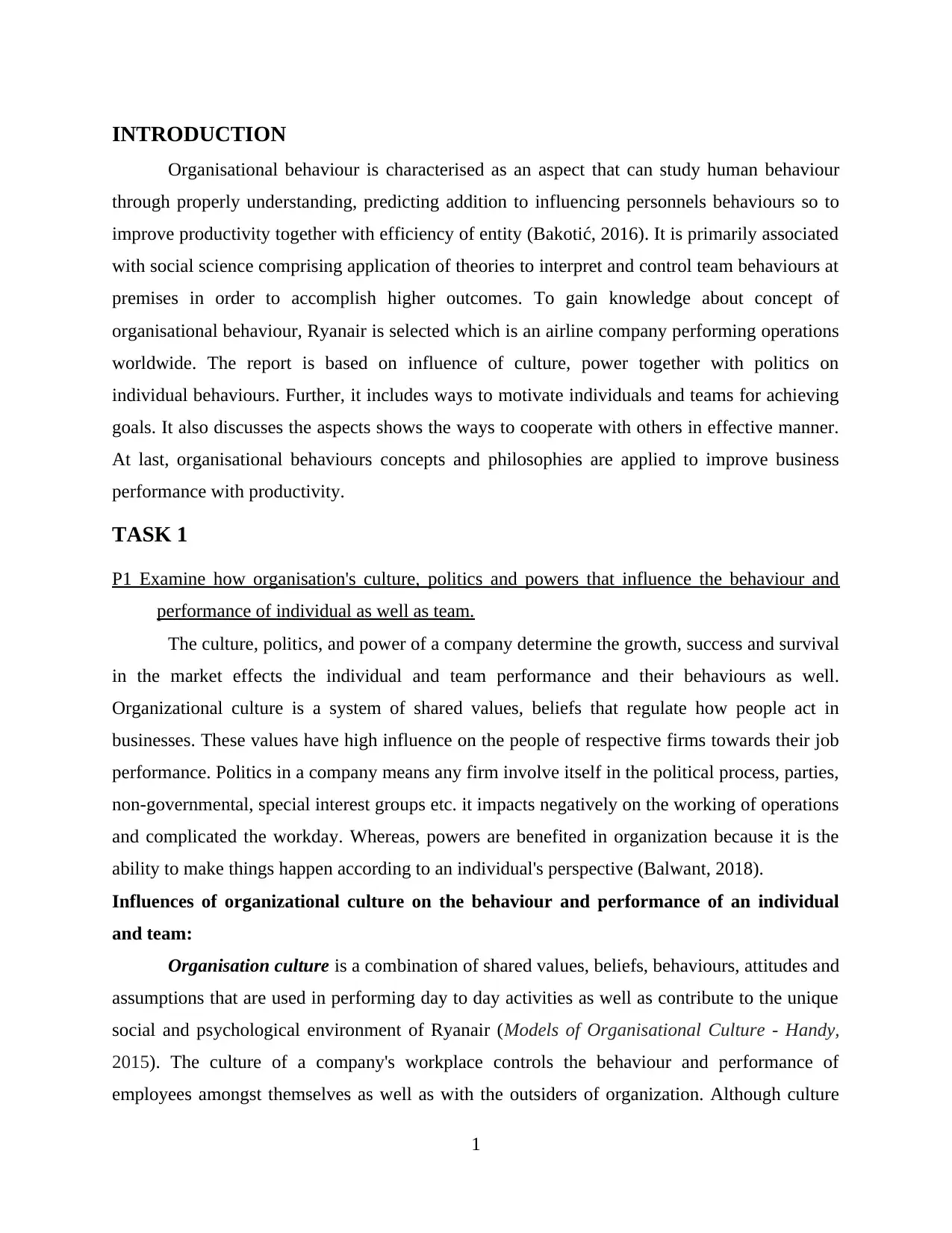
INTRODUCTION
Organisational behaviour is characterised as an aspect that can study human behaviour
through properly understanding, predicting addition to influencing personnels behaviours so to
improve productivity together with efficiency of entity (Bakotić, 2016). It is primarily associated
with social science comprising application of theories to interpret and control team behaviours at
premises in order to accomplish higher outcomes. To gain knowledge about concept of
organisational behaviour, Ryanair is selected which is an airline company performing operations
worldwide. The report is based on influence of culture, power together with politics on
individual behaviours. Further, it includes ways to motivate individuals and teams for achieving
goals. It also discusses the aspects shows the ways to cooperate with others in effective manner.
At last, organisational behaviours concepts and philosophies are applied to improve business
performance with productivity.
TASK 1
P1 Examine how organisation's culture, politics and powers that influence the behaviour and
performance of individual as well as team.
The culture, politics, and power of a company determine the growth, success and survival
in the market effects the individual and team performance and their behaviours as well.
Organizational culture is a system of shared values, beliefs that regulate how people act in
businesses. These values have high influence on the people of respective firms towards their job
performance. Politics in a company means any firm involve itself in the political process, parties,
non-governmental, special interest groups etc. it impacts negatively on the working of operations
and complicated the workday. Whereas, powers are benefited in organization because it is the
ability to make things happen according to an individual's perspective (Balwant, 2018).
Influences of organizational culture on the behaviour and performance of an individual
and team:
Organisation culture is a combination of shared values, beliefs, behaviours, attitudes and
assumptions that are used in performing day to day activities as well as contribute to the unique
social and psychological environment of Ryanair (Models of Organisational Culture - Handy,
2015). The culture of a company's workplace controls the behaviour and performance of
employees amongst themselves as well as with the outsiders of organization. Although culture
1
Organisational behaviour is characterised as an aspect that can study human behaviour
through properly understanding, predicting addition to influencing personnels behaviours so to
improve productivity together with efficiency of entity (Bakotić, 2016). It is primarily associated
with social science comprising application of theories to interpret and control team behaviours at
premises in order to accomplish higher outcomes. To gain knowledge about concept of
organisational behaviour, Ryanair is selected which is an airline company performing operations
worldwide. The report is based on influence of culture, power together with politics on
individual behaviours. Further, it includes ways to motivate individuals and teams for achieving
goals. It also discusses the aspects shows the ways to cooperate with others in effective manner.
At last, organisational behaviours concepts and philosophies are applied to improve business
performance with productivity.
TASK 1
P1 Examine how organisation's culture, politics and powers that influence the behaviour and
performance of individual as well as team.
The culture, politics, and power of a company determine the growth, success and survival
in the market effects the individual and team performance and their behaviours as well.
Organizational culture is a system of shared values, beliefs that regulate how people act in
businesses. These values have high influence on the people of respective firms towards their job
performance. Politics in a company means any firm involve itself in the political process, parties,
non-governmental, special interest groups etc. it impacts negatively on the working of operations
and complicated the workday. Whereas, powers are benefited in organization because it is the
ability to make things happen according to an individual's perspective (Balwant, 2018).
Influences of organizational culture on the behaviour and performance of an individual
and team:
Organisation culture is a combination of shared values, beliefs, behaviours, attitudes and
assumptions that are used in performing day to day activities as well as contribute to the unique
social and psychological environment of Ryanair (Models of Organisational Culture - Handy,
2015). The culture of a company's workplace controls the behaviour and performance of
employees amongst themselves as well as with the outsiders of organization. Although culture
1
⊘ This is a preview!⊘
Do you want full access?
Subscribe today to unlock all pages.

Trusted by 1+ million students worldwide
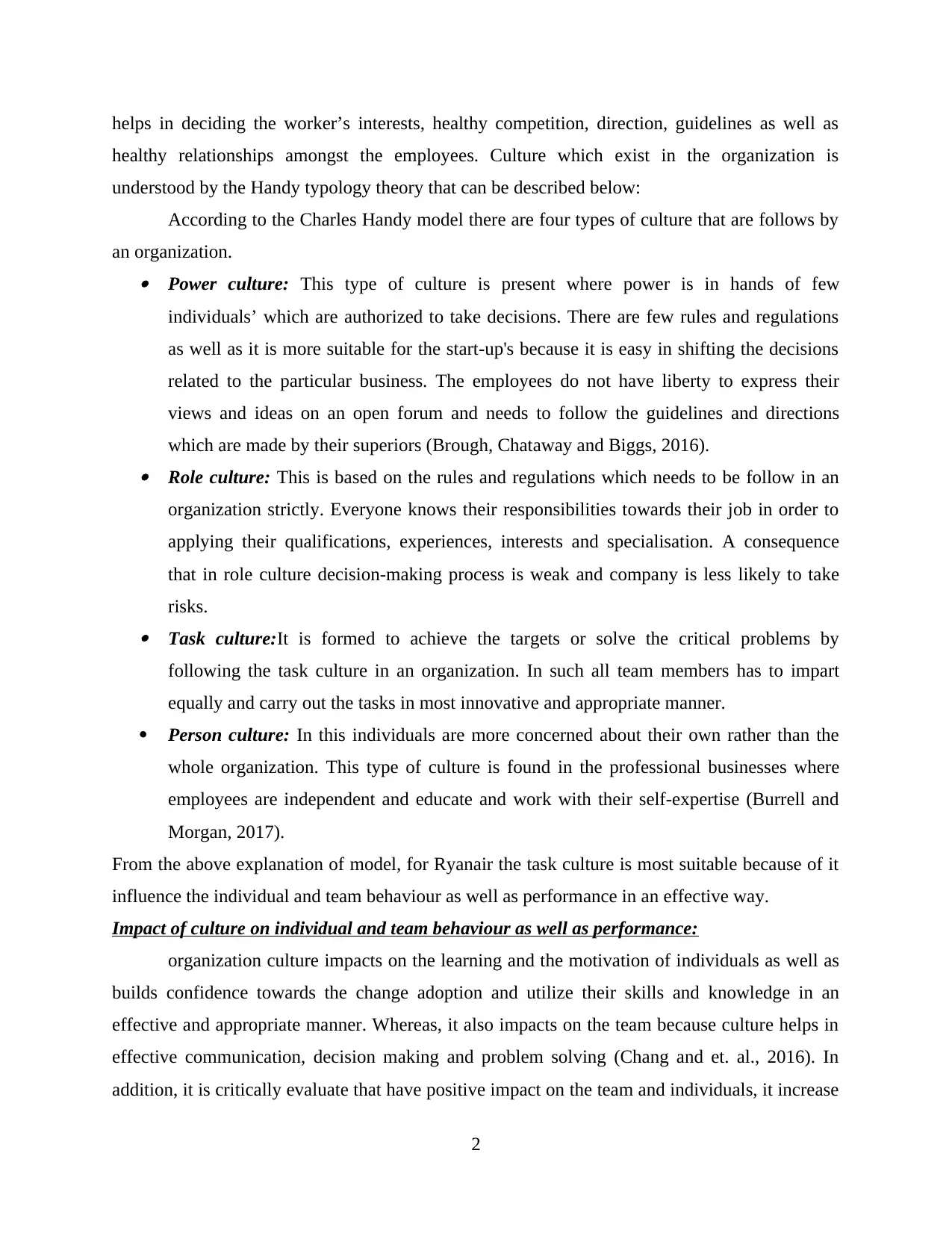
helps in deciding the worker’s interests, healthy competition, direction, guidelines as well as
healthy relationships amongst the employees. Culture which exist in the organization is
understood by the Handy typology theory that can be described below:
According to the Charles Handy model there are four types of culture that are follows by
an organization. Power culture: This type of culture is present where power is in hands of few
individuals’ which are authorized to take decisions. There are few rules and regulations
as well as it is more suitable for the start-up's because it is easy in shifting the decisions
related to the particular business. The employees do not have liberty to express their
views and ideas on an open forum and needs to follow the guidelines and directions
which are made by their superiors (Brough, Chataway and Biggs, 2016). Role culture: This is based on the rules and regulations which needs to be follow in an
organization strictly. Everyone knows their responsibilities towards their job in order to
applying their qualifications, experiences, interests and specialisation. A consequence
that in role culture decision-making process is weak and company is less likely to take
risks. Task culture:It is formed to achieve the targets or solve the critical problems by
following the task culture in an organization. In such all team members has to impart
equally and carry out the tasks in most innovative and appropriate manner.
Person culture: In this individuals are more concerned about their own rather than the
whole organization. This type of culture is found in the professional businesses where
employees are independent and educate and work with their self-expertise (Burrell and
Morgan, 2017).
From the above explanation of model, for Ryanair the task culture is most suitable because of it
influence the individual and team behaviour as well as performance in an effective way.
Impact of culture on individual and team behaviour as well as performance:
organization culture impacts on the learning and the motivation of individuals as well as
builds confidence towards the change adoption and utilize their skills and knowledge in an
effective and appropriate manner. Whereas, it also impacts on the team because culture helps in
effective communication, decision making and problem solving (Chang and et. al., 2016). In
addition, it is critically evaluate that have positive impact on the team and individuals, it increase
2
healthy relationships amongst the employees. Culture which exist in the organization is
understood by the Handy typology theory that can be described below:
According to the Charles Handy model there are four types of culture that are follows by
an organization. Power culture: This type of culture is present where power is in hands of few
individuals’ which are authorized to take decisions. There are few rules and regulations
as well as it is more suitable for the start-up's because it is easy in shifting the decisions
related to the particular business. The employees do not have liberty to express their
views and ideas on an open forum and needs to follow the guidelines and directions
which are made by their superiors (Brough, Chataway and Biggs, 2016). Role culture: This is based on the rules and regulations which needs to be follow in an
organization strictly. Everyone knows their responsibilities towards their job in order to
applying their qualifications, experiences, interests and specialisation. A consequence
that in role culture decision-making process is weak and company is less likely to take
risks. Task culture:It is formed to achieve the targets or solve the critical problems by
following the task culture in an organization. In such all team members has to impart
equally and carry out the tasks in most innovative and appropriate manner.
Person culture: In this individuals are more concerned about their own rather than the
whole organization. This type of culture is found in the professional businesses where
employees are independent and educate and work with their self-expertise (Burrell and
Morgan, 2017).
From the above explanation of model, for Ryanair the task culture is most suitable because of it
influence the individual and team behaviour as well as performance in an effective way.
Impact of culture on individual and team behaviour as well as performance:
organization culture impacts on the learning and the motivation of individuals as well as
builds confidence towards the change adoption and utilize their skills and knowledge in an
effective and appropriate manner. Whereas, it also impacts on the team because culture helps in
effective communication, decision making and problem solving (Chang and et. al., 2016). In
addition, it is critically evaluate that have positive impact on the team and individuals, it increase
2
Paraphrase This Document
Need a fresh take? Get an instant paraphrase of this document with our AI Paraphraser
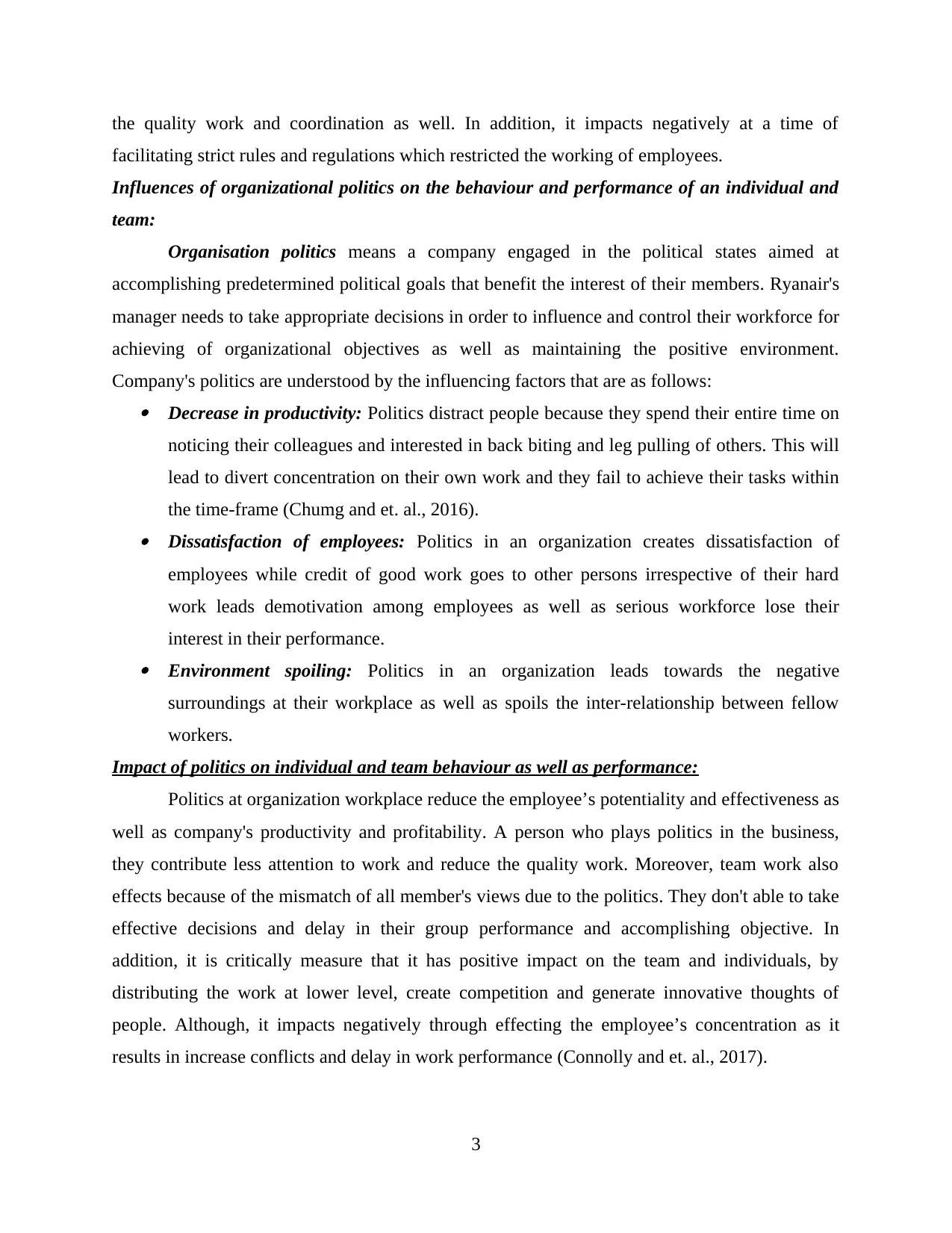
the quality work and coordination as well. In addition, it impacts negatively at a time of
facilitating strict rules and regulations which restricted the working of employees.
Influences of organizational politics on the behaviour and performance of an individual and
team:
Organisation politics means a company engaged in the political states aimed at
accomplishing predetermined political goals that benefit the interest of their members. Ryanair's
manager needs to take appropriate decisions in order to influence and control their workforce for
achieving of organizational objectives as well as maintaining the positive environment.
Company's politics are understood by the influencing factors that are as follows: Decrease in productivity: Politics distract people because they spend their entire time on
noticing their colleagues and interested in back biting and leg pulling of others. This will
lead to divert concentration on their own work and they fail to achieve their tasks within
the time-frame (Chumg and et. al., 2016). Dissatisfaction of employees: Politics in an organization creates dissatisfaction of
employees while credit of good work goes to other persons irrespective of their hard
work leads demotivation among employees as well as serious workforce lose their
interest in their performance. Environment spoiling: Politics in an organization leads towards the negative
surroundings at their workplace as well as spoils the inter-relationship between fellow
workers.
Impact of politics on individual and team behaviour as well as performance:
Politics at organization workplace reduce the employee’s potentiality and effectiveness as
well as company's productivity and profitability. A person who plays politics in the business,
they contribute less attention to work and reduce the quality work. Moreover, team work also
effects because of the mismatch of all member's views due to the politics. They don't able to take
effective decisions and delay in their group performance and accomplishing objective. In
addition, it is critically measure that it has positive impact on the team and individuals, by
distributing the work at lower level, create competition and generate innovative thoughts of
people. Although, it impacts negatively through effecting the employee’s concentration as it
results in increase conflicts and delay in work performance (Connolly and et. al., 2017).
3
facilitating strict rules and regulations which restricted the working of employees.
Influences of organizational politics on the behaviour and performance of an individual and
team:
Organisation politics means a company engaged in the political states aimed at
accomplishing predetermined political goals that benefit the interest of their members. Ryanair's
manager needs to take appropriate decisions in order to influence and control their workforce for
achieving of organizational objectives as well as maintaining the positive environment.
Company's politics are understood by the influencing factors that are as follows: Decrease in productivity: Politics distract people because they spend their entire time on
noticing their colleagues and interested in back biting and leg pulling of others. This will
lead to divert concentration on their own work and they fail to achieve their tasks within
the time-frame (Chumg and et. al., 2016). Dissatisfaction of employees: Politics in an organization creates dissatisfaction of
employees while credit of good work goes to other persons irrespective of their hard
work leads demotivation among employees as well as serious workforce lose their
interest in their performance. Environment spoiling: Politics in an organization leads towards the negative
surroundings at their workplace as well as spoils the inter-relationship between fellow
workers.
Impact of politics on individual and team behaviour as well as performance:
Politics at organization workplace reduce the employee’s potentiality and effectiveness as
well as company's productivity and profitability. A person who plays politics in the business,
they contribute less attention to work and reduce the quality work. Moreover, team work also
effects because of the mismatch of all member's views due to the politics. They don't able to take
effective decisions and delay in their group performance and accomplishing objective. In
addition, it is critically measure that it has positive impact on the team and individuals, by
distributing the work at lower level, create competition and generate innovative thoughts of
people. Although, it impacts negatively through effecting the employee’s concentration as it
results in increase conflicts and delay in work performance (Connolly and et. al., 2017).
3
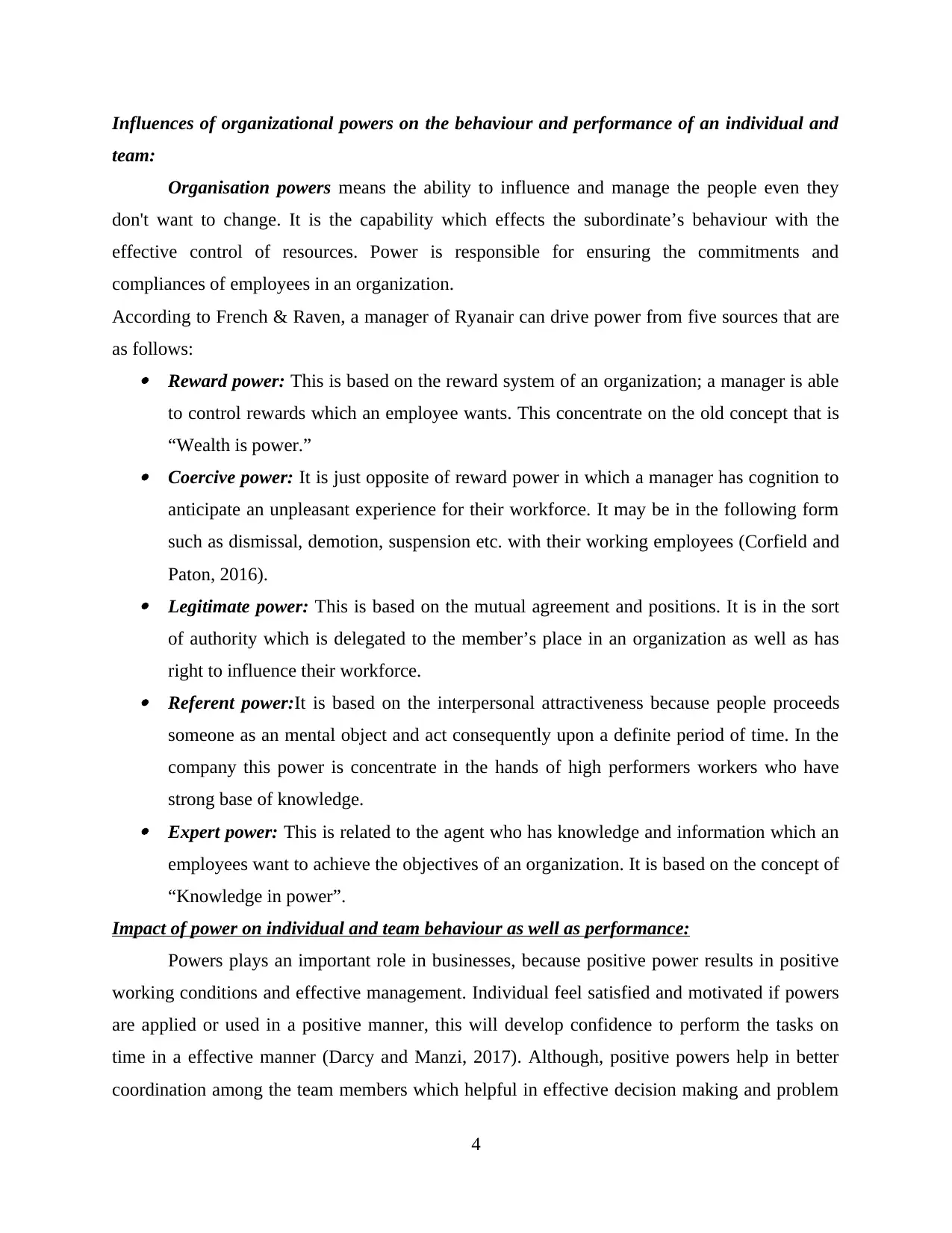
Influences of organizational powers on the behaviour and performance of an individual and
team:
Organisation powers means the ability to influence and manage the people even they
don't want to change. It is the capability which effects the subordinate’s behaviour with the
effective control of resources. Power is responsible for ensuring the commitments and
compliances of employees in an organization.
According to French & Raven, a manager of Ryanair can drive power from five sources that are
as follows: Reward power: This is based on the reward system of an organization; a manager is able
to control rewards which an employee wants. This concentrate on the old concept that is
“Wealth is power.” Coercive power: It is just opposite of reward power in which a manager has cognition to
anticipate an unpleasant experience for their workforce. It may be in the following form
such as dismissal, demotion, suspension etc. with their working employees (Corfield and
Paton, 2016). Legitimate power: This is based on the mutual agreement and positions. It is in the sort
of authority which is delegated to the member’s place in an organization as well as has
right to influence their workforce. Referent power:It is based on the interpersonal attractiveness because people proceeds
someone as an mental object and act consequently upon a definite period of time. In the
company this power is concentrate in the hands of high performers workers who have
strong base of knowledge. Expert power: This is related to the agent who has knowledge and information which an
employees want to achieve the objectives of an organization. It is based on the concept of
“Knowledge in power”.
Impact of power on individual and team behaviour as well as performance:
Powers plays an important role in businesses, because positive power results in positive
working conditions and effective management. Individual feel satisfied and motivated if powers
are applied or used in a positive manner, this will develop confidence to perform the tasks on
time in a effective manner (Darcy and Manzi, 2017). Although, positive powers help in better
coordination among the team members which helpful in effective decision making and problem
4
team:
Organisation powers means the ability to influence and manage the people even they
don't want to change. It is the capability which effects the subordinate’s behaviour with the
effective control of resources. Power is responsible for ensuring the commitments and
compliances of employees in an organization.
According to French & Raven, a manager of Ryanair can drive power from five sources that are
as follows: Reward power: This is based on the reward system of an organization; a manager is able
to control rewards which an employee wants. This concentrate on the old concept that is
“Wealth is power.” Coercive power: It is just opposite of reward power in which a manager has cognition to
anticipate an unpleasant experience for their workforce. It may be in the following form
such as dismissal, demotion, suspension etc. with their working employees (Corfield and
Paton, 2016). Legitimate power: This is based on the mutual agreement and positions. It is in the sort
of authority which is delegated to the member’s place in an organization as well as has
right to influence their workforce. Referent power:It is based on the interpersonal attractiveness because people proceeds
someone as an mental object and act consequently upon a definite period of time. In the
company this power is concentrate in the hands of high performers workers who have
strong base of knowledge. Expert power: This is related to the agent who has knowledge and information which an
employees want to achieve the objectives of an organization. It is based on the concept of
“Knowledge in power”.
Impact of power on individual and team behaviour as well as performance:
Powers plays an important role in businesses, because positive power results in positive
working conditions and effective management. Individual feel satisfied and motivated if powers
are applied or used in a positive manner, this will develop confidence to perform the tasks on
time in a effective manner (Darcy and Manzi, 2017). Although, positive powers help in better
coordination among the team members which helpful in effective decision making and problem
4
⊘ This is a preview!⊘
Do you want full access?
Subscribe today to unlock all pages.

Trusted by 1+ million students worldwide
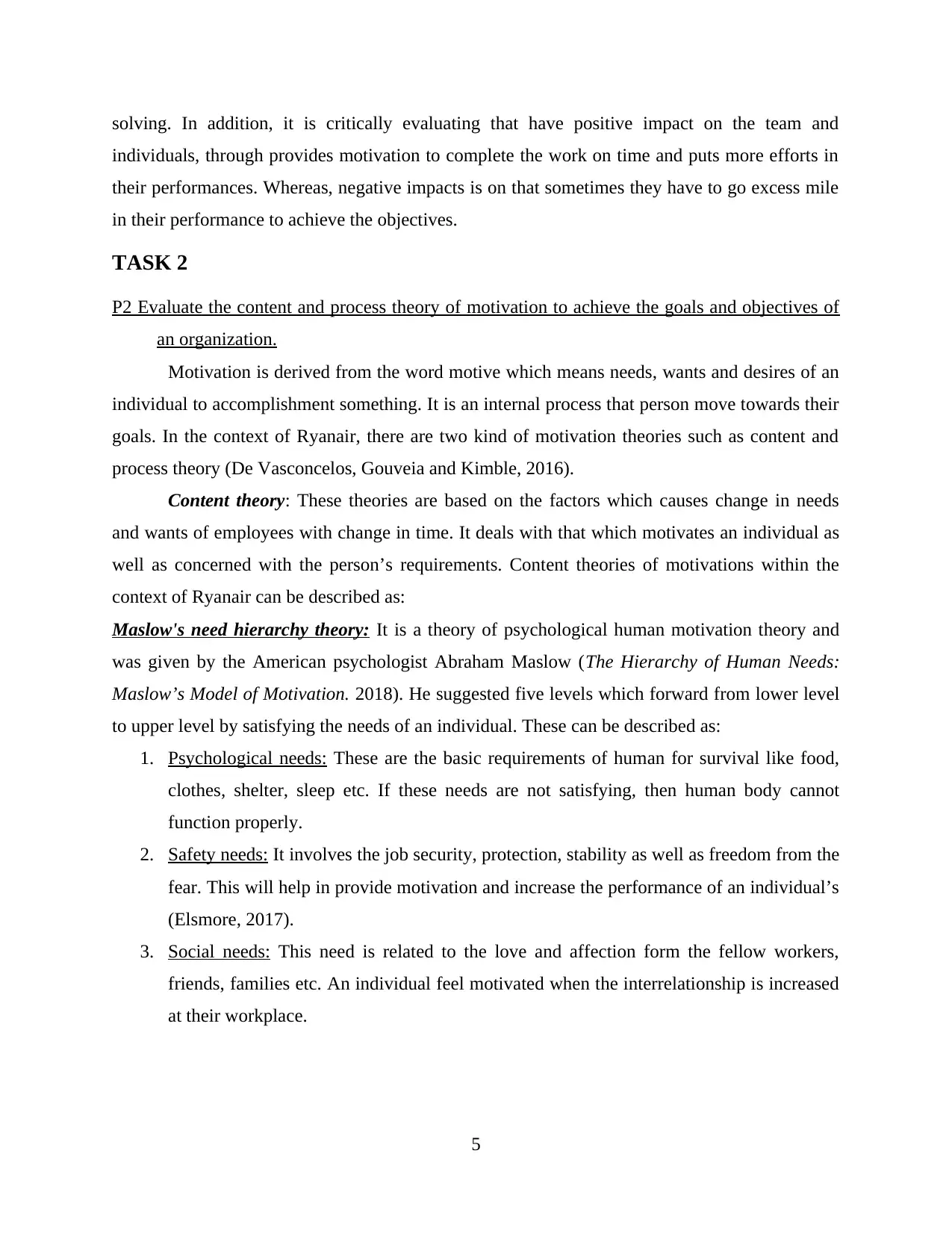
solving. In addition, it is critically evaluating that have positive impact on the team and
individuals, through provides motivation to complete the work on time and puts more efforts in
their performances. Whereas, negative impacts is on that sometimes they have to go excess mile
in their performance to achieve the objectives.
TASK 2
P2 Evaluate the content and process theory of motivation to achieve the goals and objectives of
an organization.
Motivation is derived from the word motive which means needs, wants and desires of an
individual to accomplishment something. It is an internal process that person move towards their
goals. In the context of Ryanair, there are two kind of motivation theories such as content and
process theory (De Vasconcelos, Gouveia and Kimble, 2016).
Content theory: These theories are based on the factors which causes change in needs
and wants of employees with change in time. It deals with that which motivates an individual as
well as concerned with the person’s requirements. Content theories of motivations within the
context of Ryanair can be described as:
Maslow's need hierarchy theory: It is a theory of psychological human motivation theory and
was given by the American psychologist Abraham Maslow (The Hierarchy of Human Needs:
Maslow’s Model of Motivation. 2018). He suggested five levels which forward from lower level
to upper level by satisfying the needs of an individual. These can be described as:
1. Psychological needs: These are the basic requirements of human for survival like food,
clothes, shelter, sleep etc. If these needs are not satisfying, then human body cannot
function properly.
2. Safety needs: It involves the job security, protection, stability as well as freedom from the
fear. This will help in provide motivation and increase the performance of an individual’s
(Elsmore, 2017).
3. Social needs: This need is related to the love and affection form the fellow workers,
friends, families etc. An individual feel motivated when the interrelationship is increased
at their workplace.
5
individuals, through provides motivation to complete the work on time and puts more efforts in
their performances. Whereas, negative impacts is on that sometimes they have to go excess mile
in their performance to achieve the objectives.
TASK 2
P2 Evaluate the content and process theory of motivation to achieve the goals and objectives of
an organization.
Motivation is derived from the word motive which means needs, wants and desires of an
individual to accomplishment something. It is an internal process that person move towards their
goals. In the context of Ryanair, there are two kind of motivation theories such as content and
process theory (De Vasconcelos, Gouveia and Kimble, 2016).
Content theory: These theories are based on the factors which causes change in needs
and wants of employees with change in time. It deals with that which motivates an individual as
well as concerned with the person’s requirements. Content theories of motivations within the
context of Ryanair can be described as:
Maslow's need hierarchy theory: It is a theory of psychological human motivation theory and
was given by the American psychologist Abraham Maslow (The Hierarchy of Human Needs:
Maslow’s Model of Motivation. 2018). He suggested five levels which forward from lower level
to upper level by satisfying the needs of an individual. These can be described as:
1. Psychological needs: These are the basic requirements of human for survival like food,
clothes, shelter, sleep etc. If these needs are not satisfying, then human body cannot
function properly.
2. Safety needs: It involves the job security, protection, stability as well as freedom from the
fear. This will help in provide motivation and increase the performance of an individual’s
(Elsmore, 2017).
3. Social needs: This need is related to the love and affection form the fellow workers,
friends, families etc. An individual feel motivated when the interrelationship is increased
at their workplace.
5
Paraphrase This Document
Need a fresh take? Get an instant paraphrase of this document with our AI Paraphraser
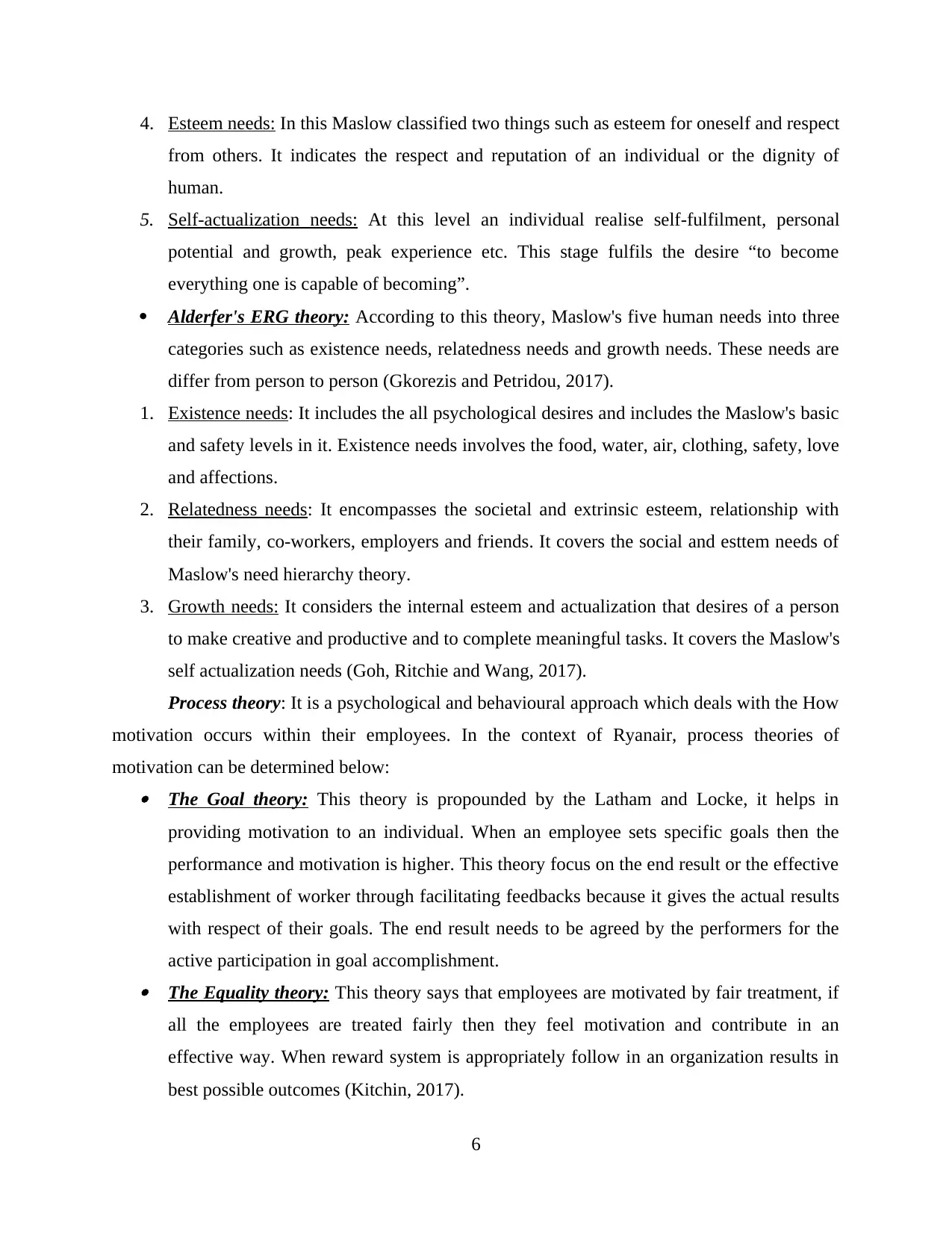
4. Esteem needs: In this Maslow classified two things such as esteem for oneself and respect
from others. It indicates the respect and reputation of an individual or the dignity of
human.
5. Self-actualization needs: At this level an individual realise self-fulfilment, personal
potential and growth, peak experience etc. This stage fulfils the desire “to become
everything one is capable of becoming”.
Alderfer's ERG theory: According to this theory, Maslow's five human needs into three
categories such as existence needs, relatedness needs and growth needs. These needs are
differ from person to person (Gkorezis and Petridou, 2017).
1. Existence needs: It includes the all psychological desires and includes the Maslow's basic
and safety levels in it. Existence needs involves the food, water, air, clothing, safety, love
and affections.
2. Relatedness needs: It encompasses the societal and extrinsic esteem, relationship with
their family, co-workers, employers and friends. It covers the social and esttem needs of
Maslow's need hierarchy theory.
3. Growth needs: It considers the internal esteem and actualization that desires of a person
to make creative and productive and to complete meaningful tasks. It covers the Maslow's
self actualization needs (Goh, Ritchie and Wang, 2017).
Process theory: It is a psychological and behavioural approach which deals with the How
motivation occurs within their employees. In the context of Ryanair, process theories of
motivation can be determined below: The Goal theory: This theory is propounded by the Latham and Locke, it helps in
providing motivation to an individual. When an employee sets specific goals then the
performance and motivation is higher. This theory focus on the end result or the effective
establishment of worker through facilitating feedbacks because it gives the actual results
with respect of their goals. The end result needs to be agreed by the performers for the
active participation in goal accomplishment. The Equality theory: This theory says that employees are motivated by fair treatment, if
all the employees are treated fairly then they feel motivation and contribute in an
effective way. When reward system is appropriately follow in an organization results in
best possible outcomes (Kitchin, 2017).
6
from others. It indicates the respect and reputation of an individual or the dignity of
human.
5. Self-actualization needs: At this level an individual realise self-fulfilment, personal
potential and growth, peak experience etc. This stage fulfils the desire “to become
everything one is capable of becoming”.
Alderfer's ERG theory: According to this theory, Maslow's five human needs into three
categories such as existence needs, relatedness needs and growth needs. These needs are
differ from person to person (Gkorezis and Petridou, 2017).
1. Existence needs: It includes the all psychological desires and includes the Maslow's basic
and safety levels in it. Existence needs involves the food, water, air, clothing, safety, love
and affections.
2. Relatedness needs: It encompasses the societal and extrinsic esteem, relationship with
their family, co-workers, employers and friends. It covers the social and esttem needs of
Maslow's need hierarchy theory.
3. Growth needs: It considers the internal esteem and actualization that desires of a person
to make creative and productive and to complete meaningful tasks. It covers the Maslow's
self actualization needs (Goh, Ritchie and Wang, 2017).
Process theory: It is a psychological and behavioural approach which deals with the How
motivation occurs within their employees. In the context of Ryanair, process theories of
motivation can be determined below: The Goal theory: This theory is propounded by the Latham and Locke, it helps in
providing motivation to an individual. When an employee sets specific goals then the
performance and motivation is higher. This theory focus on the end result or the effective
establishment of worker through facilitating feedbacks because it gives the actual results
with respect of their goals. The end result needs to be agreed by the performers for the
active participation in goal accomplishment. The Equality theory: This theory says that employees are motivated by fair treatment, if
all the employees are treated fairly then they feel motivation and contribute in an
effective way. When reward system is appropriately follow in an organization results in
best possible outcomes (Kitchin, 2017).
6
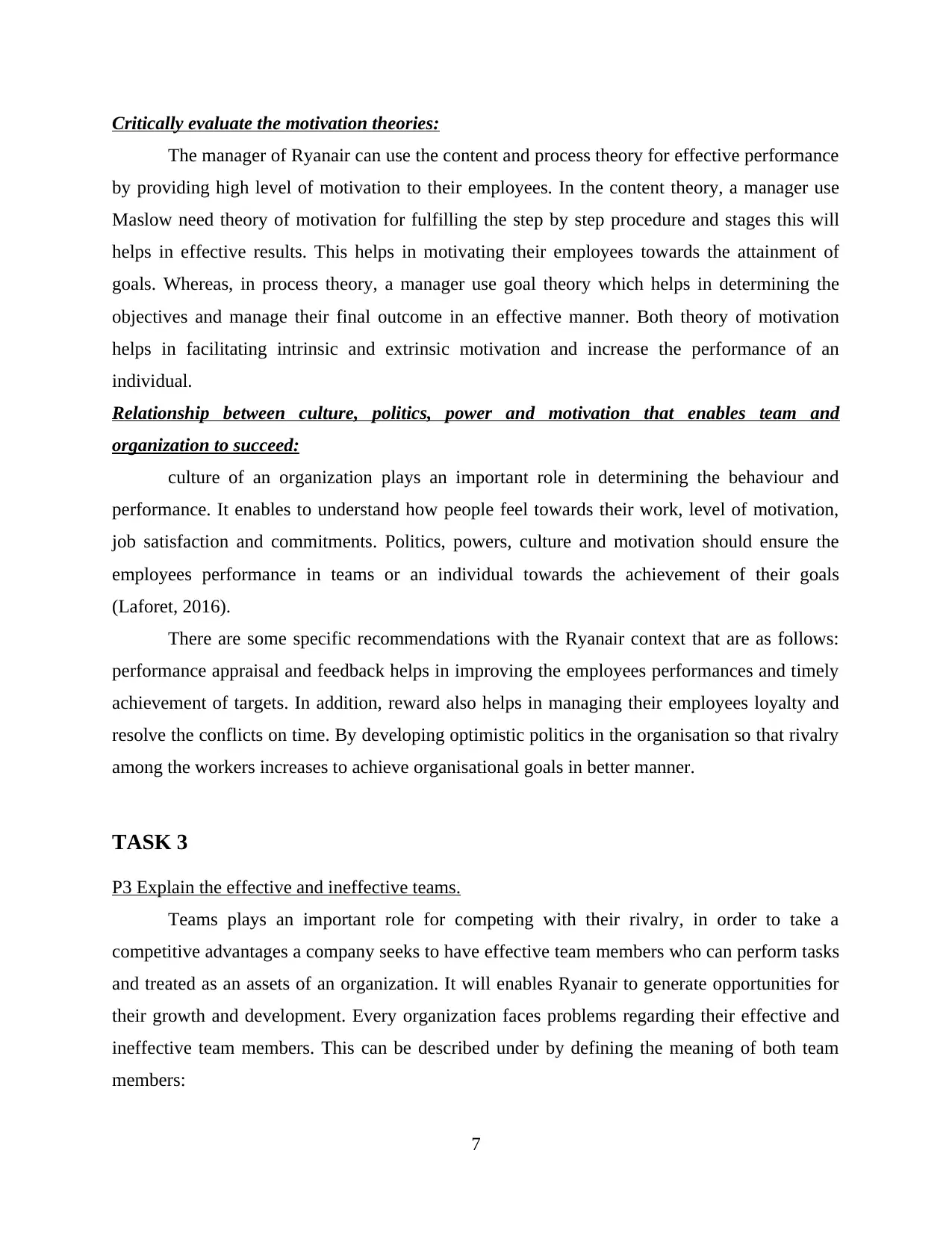
Critically evaluate the motivation theories:
The manager of Ryanair can use the content and process theory for effective performance
by providing high level of motivation to their employees. In the content theory, a manager use
Maslow need theory of motivation for fulfilling the step by step procedure and stages this will
helps in effective results. This helps in motivating their employees towards the attainment of
goals. Whereas, in process theory, a manager use goal theory which helps in determining the
objectives and manage their final outcome in an effective manner. Both theory of motivation
helps in facilitating intrinsic and extrinsic motivation and increase the performance of an
individual.
Relationship between culture, politics, power and motivation that enables team and
organization to succeed:
culture of an organization plays an important role in determining the behaviour and
performance. It enables to understand how people feel towards their work, level of motivation,
job satisfaction and commitments. Politics, powers, culture and motivation should ensure the
employees performance in teams or an individual towards the achievement of their goals
(Laforet, 2016).
There are some specific recommendations with the Ryanair context that are as follows:
performance appraisal and feedback helps in improving the employees performances and timely
achievement of targets. In addition, reward also helps in managing their employees loyalty and
resolve the conflicts on time. By developing optimistic politics in the organisation so that rivalry
among the workers increases to achieve organisational goals in better manner.
TASK 3
P3 Explain the effective and ineffective teams.
Teams plays an important role for competing with their rivalry, in order to take a
competitive advantages a company seeks to have effective team members who can perform tasks
and treated as an assets of an organization. It will enables Ryanair to generate opportunities for
their growth and development. Every organization faces problems regarding their effective and
ineffective team members. This can be described under by defining the meaning of both team
members:
7
The manager of Ryanair can use the content and process theory for effective performance
by providing high level of motivation to their employees. In the content theory, a manager use
Maslow need theory of motivation for fulfilling the step by step procedure and stages this will
helps in effective results. This helps in motivating their employees towards the attainment of
goals. Whereas, in process theory, a manager use goal theory which helps in determining the
objectives and manage their final outcome in an effective manner. Both theory of motivation
helps in facilitating intrinsic and extrinsic motivation and increase the performance of an
individual.
Relationship between culture, politics, power and motivation that enables team and
organization to succeed:
culture of an organization plays an important role in determining the behaviour and
performance. It enables to understand how people feel towards their work, level of motivation,
job satisfaction and commitments. Politics, powers, culture and motivation should ensure the
employees performance in teams or an individual towards the achievement of their goals
(Laforet, 2016).
There are some specific recommendations with the Ryanair context that are as follows:
performance appraisal and feedback helps in improving the employees performances and timely
achievement of targets. In addition, reward also helps in managing their employees loyalty and
resolve the conflicts on time. By developing optimistic politics in the organisation so that rivalry
among the workers increases to achieve organisational goals in better manner.
TASK 3
P3 Explain the effective and ineffective teams.
Teams plays an important role for competing with their rivalry, in order to take a
competitive advantages a company seeks to have effective team members who can perform tasks
and treated as an assets of an organization. It will enables Ryanair to generate opportunities for
their growth and development. Every organization faces problems regarding their effective and
ineffective team members. This can be described under by defining the meaning of both team
members:
7
⊘ This is a preview!⊘
Do you want full access?
Subscribe today to unlock all pages.

Trusted by 1+ million students worldwide
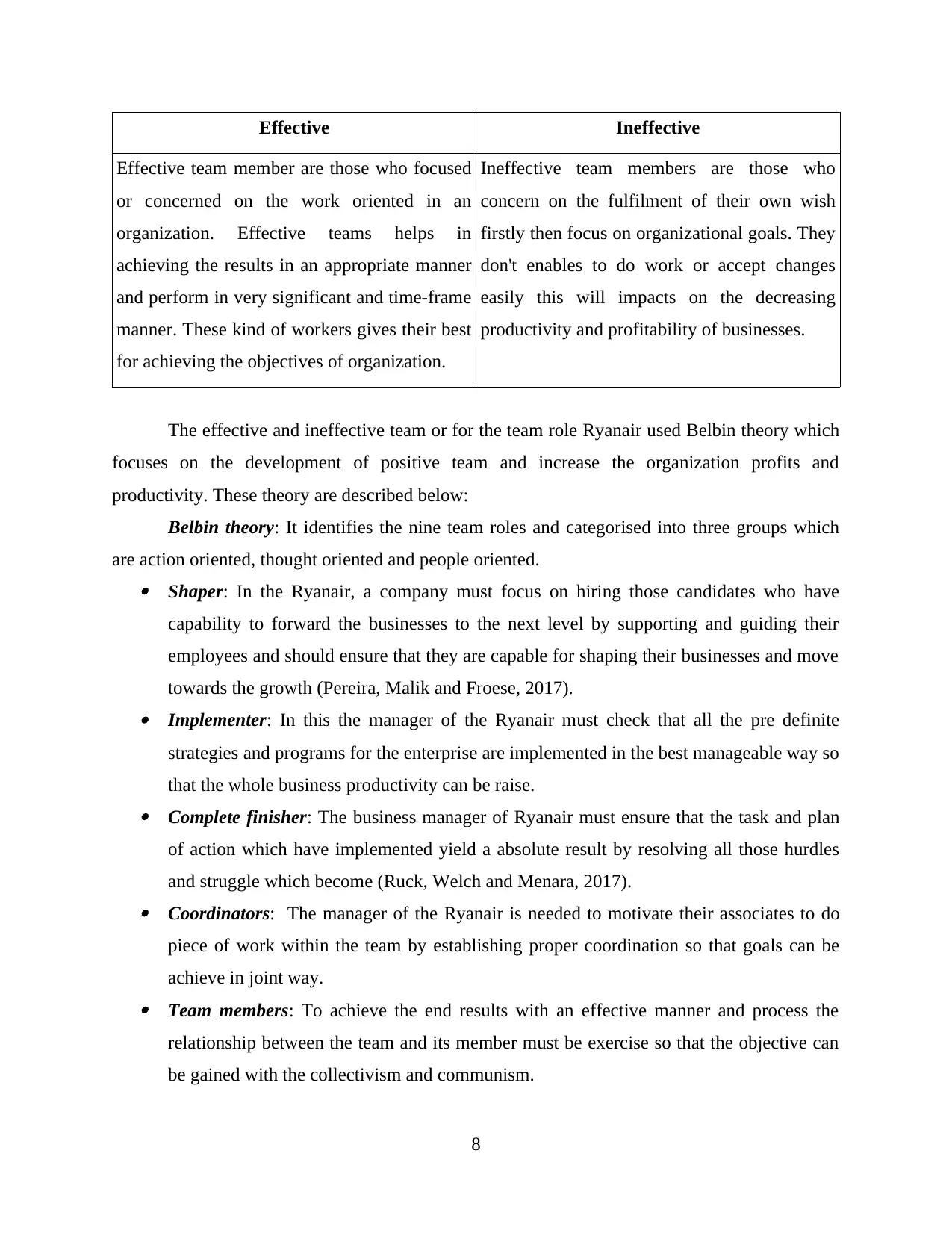
Effective Ineffective
Effective team member are those who focused
or concerned on the work oriented in an
organization. Effective teams helps in
achieving the results in an appropriate manner
and perform in very significant and time-frame
manner. These kind of workers gives their best
for achieving the objectives of organization.
Ineffective team members are those who
concern on the fulfilment of their own wish
firstly then focus on organizational goals. They
don't enables to do work or accept changes
easily this will impacts on the decreasing
productivity and profitability of businesses.
The effective and ineffective team or for the team role Ryanair used Belbin theory which
focuses on the development of positive team and increase the organization profits and
productivity. These theory are described below:
Belbin theory: It identifies the nine team roles and categorised into three groups which
are action oriented, thought oriented and people oriented. Shaper: In the Ryanair, a company must focus on hiring those candidates who have
capability to forward the businesses to the next level by supporting and guiding their
employees and should ensure that they are capable for shaping their businesses and move
towards the growth (Pereira, Malik and Froese, 2017). Implementer: In this the manager of the Ryanair must check that all the pre definite
strategies and programs for the enterprise are implemented in the best manageable way so
that the whole business productivity can be raise. Complete finisher: The business manager of Ryanair must ensure that the task and plan
of action which have implemented yield a absolute result by resolving all those hurdles
and struggle which become (Ruck, Welch and Menara, 2017). Coordinators: The manager of the Ryanair is needed to motivate their associates to do
piece of work within the team by establishing proper coordination so that goals can be
achieve in joint way. Team members: To achieve the end results with an effective manner and process the
relationship between the team and its member must be exercise so that the objective can
be gained with the collectivism and communism.
8
Effective team member are those who focused
or concerned on the work oriented in an
organization. Effective teams helps in
achieving the results in an appropriate manner
and perform in very significant and time-frame
manner. These kind of workers gives their best
for achieving the objectives of organization.
Ineffective team members are those who
concern on the fulfilment of their own wish
firstly then focus on organizational goals. They
don't enables to do work or accept changes
easily this will impacts on the decreasing
productivity and profitability of businesses.
The effective and ineffective team or for the team role Ryanair used Belbin theory which
focuses on the development of positive team and increase the organization profits and
productivity. These theory are described below:
Belbin theory: It identifies the nine team roles and categorised into three groups which
are action oriented, thought oriented and people oriented. Shaper: In the Ryanair, a company must focus on hiring those candidates who have
capability to forward the businesses to the next level by supporting and guiding their
employees and should ensure that they are capable for shaping their businesses and move
towards the growth (Pereira, Malik and Froese, 2017). Implementer: In this the manager of the Ryanair must check that all the pre definite
strategies and programs for the enterprise are implemented in the best manageable way so
that the whole business productivity can be raise. Complete finisher: The business manager of Ryanair must ensure that the task and plan
of action which have implemented yield a absolute result by resolving all those hurdles
and struggle which become (Ruck, Welch and Menara, 2017). Coordinators: The manager of the Ryanair is needed to motivate their associates to do
piece of work within the team by establishing proper coordination so that goals can be
achieve in joint way. Team members: To achieve the end results with an effective manner and process the
relationship between the team and its member must be exercise so that the objective can
be gained with the collectivism and communism.
8
Paraphrase This Document
Need a fresh take? Get an instant paraphrase of this document with our AI Paraphraser
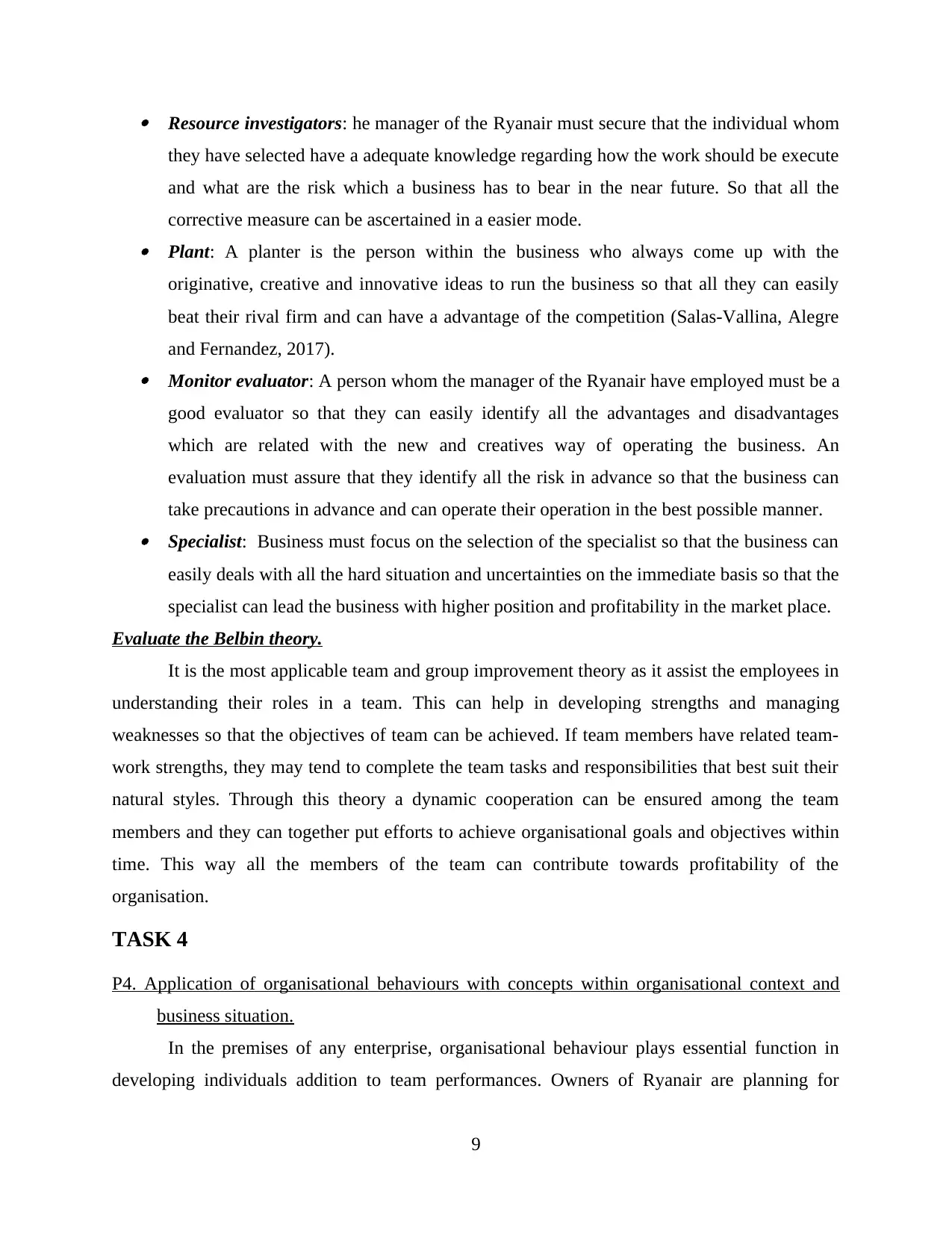
Resource investigators: he manager of the Ryanair must secure that the individual whom
they have selected have a adequate knowledge regarding how the work should be execute
and what are the risk which a business has to bear in the near future. So that all the
corrective measure can be ascertained in a easier mode. Plant: A planter is the person within the business who always come up with the
originative, creative and innovative ideas to run the business so that all they can easily
beat their rival firm and can have a advantage of the competition (Salas-Vallina, Alegre
and Fernandez, 2017). Monitor evaluator: A person whom the manager of the Ryanair have employed must be a
good evaluator so that they can easily identify all the advantages and disadvantages
which are related with the new and creatives way of operating the business. An
evaluation must assure that they identify all the risk in advance so that the business can
take precautions in advance and can operate their operation in the best possible manner. Specialist: Business must focus on the selection of the specialist so that the business can
easily deals with all the hard situation and uncertainties on the immediate basis so that the
specialist can lead the business with higher position and profitability in the market place.
Evaluate the Belbin theory.
It is the most applicable team and group improvement theory as it assist the employees in
understanding their roles in a team. This can help in developing strengths and managing
weaknesses so that the objectives of team can be achieved. If team members have related team-
work strengths, they may tend to complete the team tasks and responsibilities that best suit their
natural styles. Through this theory a dynamic cooperation can be ensured among the team
members and they can together put efforts to achieve organisational goals and objectives within
time. This way all the members of the team can contribute towards profitability of the
organisation.
TASK 4
P4. Application of organisational behaviours with concepts within organisational context and
business situation.
In the premises of any enterprise, organisational behaviour plays essential function in
developing individuals addition to team performances. Owners of Ryanair are planning for
9
they have selected have a adequate knowledge regarding how the work should be execute
and what are the risk which a business has to bear in the near future. So that all the
corrective measure can be ascertained in a easier mode. Plant: A planter is the person within the business who always come up with the
originative, creative and innovative ideas to run the business so that all they can easily
beat their rival firm and can have a advantage of the competition (Salas-Vallina, Alegre
and Fernandez, 2017). Monitor evaluator: A person whom the manager of the Ryanair have employed must be a
good evaluator so that they can easily identify all the advantages and disadvantages
which are related with the new and creatives way of operating the business. An
evaluation must assure that they identify all the risk in advance so that the business can
take precautions in advance and can operate their operation in the best possible manner. Specialist: Business must focus on the selection of the specialist so that the business can
easily deals with all the hard situation and uncertainties on the immediate basis so that the
specialist can lead the business with higher position and profitability in the market place.
Evaluate the Belbin theory.
It is the most applicable team and group improvement theory as it assist the employees in
understanding their roles in a team. This can help in developing strengths and managing
weaknesses so that the objectives of team can be achieved. If team members have related team-
work strengths, they may tend to complete the team tasks and responsibilities that best suit their
natural styles. Through this theory a dynamic cooperation can be ensured among the team
members and they can together put efforts to achieve organisational goals and objectives within
time. This way all the members of the team can contribute towards profitability of the
organisation.
TASK 4
P4. Application of organisational behaviours with concepts within organisational context and
business situation.
In the premises of any enterprise, organisational behaviour plays essential function in
developing individuals addition to team performances. Owners of Ryanair are planning for
9
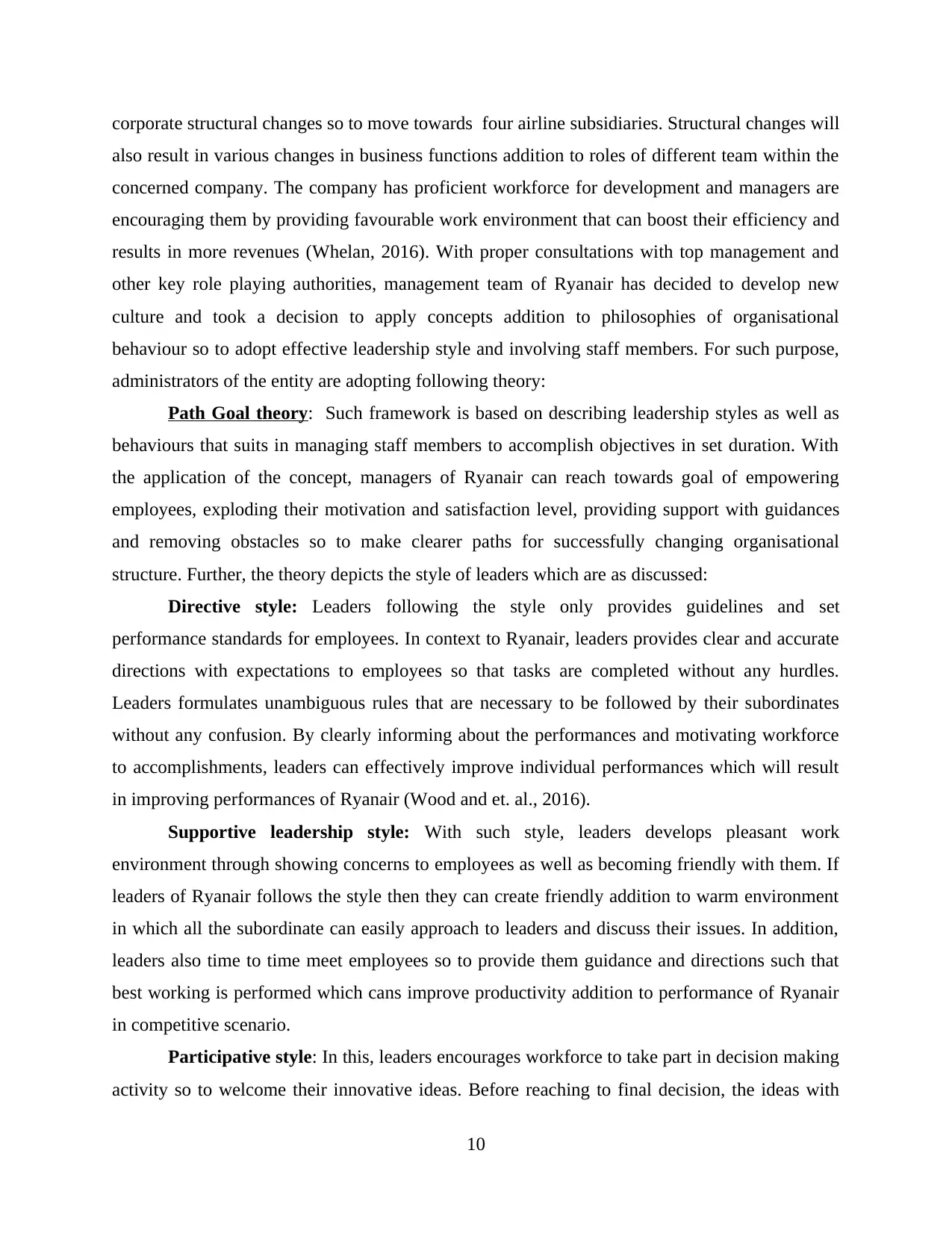
corporate structural changes so to move towards four airline subsidiaries. Structural changes will
also result in various changes in business functions addition to roles of different team within the
concerned company. The company has proficient workforce for development and managers are
encouraging them by providing favourable work environment that can boost their efficiency and
results in more revenues (Whelan, 2016). With proper consultations with top management and
other key role playing authorities, management team of Ryanair has decided to develop new
culture and took a decision to apply concepts addition to philosophies of organisational
behaviour so to adopt effective leadership style and involving staff members. For such purpose,
administrators of the entity are adopting following theory:
Path Goal theory: Such framework is based on describing leadership styles as well as
behaviours that suits in managing staff members to accomplish objectives in set duration. With
the application of the concept, managers of Ryanair can reach towards goal of empowering
employees, exploding their motivation and satisfaction level, providing support with guidances
and removing obstacles so to make clearer paths for successfully changing organisational
structure. Further, the theory depicts the style of leaders which are as discussed:
Directive style: Leaders following the style only provides guidelines and set
performance standards for employees. In context to Ryanair, leaders provides clear and accurate
directions with expectations to employees so that tasks are completed without any hurdles.
Leaders formulates unambiguous rules that are necessary to be followed by their subordinates
without any confusion. By clearly informing about the performances and motivating workforce
to accomplishments, leaders can effectively improve individual performances which will result
in improving performances of Ryanair (Wood and et. al., 2016).
Supportive leadership style: With such style, leaders develops pleasant work
environment through showing concerns to employees as well as becoming friendly with them. If
leaders of Ryanair follows the style then they can create friendly addition to warm environment
in which all the subordinate can easily approach to leaders and discuss their issues. In addition,
leaders also time to time meet employees so to provide them guidance and directions such that
best working is performed which cans improve productivity addition to performance of Ryanair
in competitive scenario.
Participative style: In this, leaders encourages workforce to take part in decision making
activity so to welcome their innovative ideas. Before reaching to final decision, the ideas with
10
also result in various changes in business functions addition to roles of different team within the
concerned company. The company has proficient workforce for development and managers are
encouraging them by providing favourable work environment that can boost their efficiency and
results in more revenues (Whelan, 2016). With proper consultations with top management and
other key role playing authorities, management team of Ryanair has decided to develop new
culture and took a decision to apply concepts addition to philosophies of organisational
behaviour so to adopt effective leadership style and involving staff members. For such purpose,
administrators of the entity are adopting following theory:
Path Goal theory: Such framework is based on describing leadership styles as well as
behaviours that suits in managing staff members to accomplish objectives in set duration. With
the application of the concept, managers of Ryanair can reach towards goal of empowering
employees, exploding their motivation and satisfaction level, providing support with guidances
and removing obstacles so to make clearer paths for successfully changing organisational
structure. Further, the theory depicts the style of leaders which are as discussed:
Directive style: Leaders following the style only provides guidelines and set
performance standards for employees. In context to Ryanair, leaders provides clear and accurate
directions with expectations to employees so that tasks are completed without any hurdles.
Leaders formulates unambiguous rules that are necessary to be followed by their subordinates
without any confusion. By clearly informing about the performances and motivating workforce
to accomplishments, leaders can effectively improve individual performances which will result
in improving performances of Ryanair (Wood and et. al., 2016).
Supportive leadership style: With such style, leaders develops pleasant work
environment through showing concerns to employees as well as becoming friendly with them. If
leaders of Ryanair follows the style then they can create friendly addition to warm environment
in which all the subordinate can easily approach to leaders and discuss their issues. In addition,
leaders also time to time meet employees so to provide them guidance and directions such that
best working is performed which cans improve productivity addition to performance of Ryanair
in competitive scenario.
Participative style: In this, leaders encourages workforce to take part in decision making
activity so to welcome their innovative ideas. Before reaching to final decision, the ideas with
10
⊘ This is a preview!⊘
Do you want full access?
Subscribe today to unlock all pages.

Trusted by 1+ million students worldwide
1 out of 16
Related Documents
Your All-in-One AI-Powered Toolkit for Academic Success.
+13062052269
info@desklib.com
Available 24*7 on WhatsApp / Email
![[object Object]](/_next/static/media/star-bottom.7253800d.svg)
Unlock your academic potential
Copyright © 2020–2025 A2Z Services. All Rights Reserved. Developed and managed by ZUCOL.



